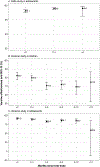Real-World Effectiveness of BNT162b2 Against Infection and Severe Diseases in Children and Adolescents
- PMID: 38190711
- PMCID: PMC11956830
- DOI: 10.7326/M23-1754
Real-World Effectiveness of BNT162b2 Against Infection and Severe Diseases in Children and Adolescents
Abstract
Background: The efficacy of the BNT162b2 vaccine in pediatrics was assessed by randomized trials before the Omicron variant's emergence. The long-term durability of vaccine protection in this population during the Omicron period remains limited.
Objective: To assess the effectiveness of BNT162b2 in preventing infection and severe diseases with various strains of the SARS-CoV-2 virus in previously uninfected children and adolescents.
Design: Comparative effectiveness research accounting for underreported vaccination in 3 study cohorts: adolescents (12 to 20 years) during the Delta phase and children (5 to 11 years) and adolescents (12 to 20 years) during the Omicron phase.
Setting: A national collaboration of pediatric health systems (PEDSnet).
Participants: 77 392 adolescents (45 007 vaccinated) during the Delta phase and 111 539 children (50 398 vaccinated) and 56 080 adolescents (21 180 vaccinated) during the Omicron phase.
Intervention: First dose of the BNT162b2 vaccine versus no receipt of COVID-19 vaccine.
Measurements: Outcomes of interest include documented infection, COVID-19 illness severity, admission to an intensive care unit (ICU), and cardiac complications. The effectiveness was reported as (1-relative risk)*100, with confounders balanced via propensity score stratification.
Results: During the Delta period, the estimated effectiveness of the BNT162b2 vaccine was 98.4% (95% CI, 98.1% to 98.7%) against documented infection among adolescents, with no statistically significant waning after receipt of the first dose. An analysis of cardiac complications did not suggest a statistically significant difference between vaccinated and unvaccinated groups. During the Omicron period, the effectiveness against documented infection among children was estimated to be 74.3% (CI, 72.2% to 76.2%). Higher levels of effectiveness were seen against moderate or severe COVID-19 (75.5% [CI, 69.0% to 81.0%]) and ICU admission with COVID-19 (84.9% [CI, 64.8% to 93.5%]). Among adolescents, the effectiveness against documented Omicron infection was 85.5% (CI, 83.8% to 87.1%), with 84.8% (CI, 77.3% to 89.9%) against moderate or severe COVID-19, and 91.5% (CI, 69.5% to 97.6%) against ICU admission with COVID-19. The effectiveness of the BNT162b2 vaccine against the Omicron variant declined 4 months after the first dose and then stabilized. The analysis showed a lower risk for cardiac complications in the vaccinated group during the Omicron variant period.
Limitation: Observational study design and potentially undocumented infection.
Conclusion: This study suggests that BNT162b2 was effective for various COVID-19-related outcomes in children and adolescents during the Delta and Omicron periods, and there is some evidence of waning effectiveness over time.
Primary funding source: National Institutes of Health.
Conflict of interest statement
Figures


Update of
-
Real-world Effectiveness of BNT162b2 Against Infection and Severe Diseases in Children and Adolescents.medRxiv [Preprint]. 2023 Nov 13:2023.06.16.23291515. doi: 10.1101/2023.06.16.23291515. medRxiv. 2023. Update in: Ann Intern Med. 2024 Feb;177(2):165-176. doi: 10.7326/M23-1754. PMID: 38014095 Free PMC article. Updated. Preprint.
Similar articles
-
Real-world Effectiveness of BNT162b2 Against Infection and Severe Diseases in Children and Adolescents.medRxiv [Preprint]. 2023 Nov 13:2023.06.16.23291515. doi: 10.1101/2023.06.16.23291515. medRxiv. 2023. Update in: Ann Intern Med. 2024 Feb;177(2):165-176. doi: 10.7326/M23-1754. PMID: 38014095 Free PMC article. Updated. Preprint.
-
Real-world effectiveness and causal mediation study of BNT162b2 on long COVID risks in children and adolescents.EClinicalMedicine. 2024 Dec 6;79:102962. doi: 10.1016/j.eclinm.2024.102962. eCollection 2025 Jan. EClinicalMedicine. 2024. PMID: 39720603 Free PMC article.
-
BNT162b2 vaccine protection against omicron and effect of previous infection variant and vaccination sequence among children and adolescents in Singapore: a population-based cohort study.Lancet Child Adolesc Health. 2023 Jul;7(7):463-470. doi: 10.1016/S2352-4642(23)00101-3. Epub 2023 May 15. Lancet Child Adolesc Health. 2023. PMID: 37201540 Free PMC article.
-
Safety and effectiveness of vaccines against COVID-19 in children aged 5-11 years: a systematic review and meta-analysis.Lancet Child Adolesc Health. 2023 Jun;7(6):379-391. doi: 10.1016/S2352-4642(23)00078-0. Epub 2023 Apr 18. Lancet Child Adolesc Health. 2023. PMID: 37084750 Free PMC article.
-
A Systematic Review of Coronavirus Disease 2019 Vaccine Efficacy and Effectiveness Against Severe Acute Respiratory Syndrome Coronavirus 2 Infection and Disease.Open Forum Infect Dis. 2022 Apr 18;9(6):ofac138. doi: 10.1093/ofid/ofac138. eCollection 2022 Jun. Open Forum Infect Dis. 2022. PMID: 35611346 Free PMC article. Review.
Cited by
-
COVID-19 vaccination-related tinnitus is associated with pre-vaccination metabolic disorders.Front Pharmacol. 2024 May 22;15:1374320. doi: 10.3389/fphar.2024.1374320. eCollection 2024. Front Pharmacol. 2024. PMID: 38841369 Free PMC article.
-
A latent transfer learning method for estimating hospital-specific post-acute healthcare demands following SARS-CoV-2 infection.Patterns (N Y). 2024 Oct 24;5(11):101079. doi: 10.1016/j.patter.2024.101079. eCollection 2024 Nov 8. Patterns (N Y). 2024. PMID: 39568467 Free PMC article.
-
Vaccine Effectiveness Among 5- to 17-year-old Individuals with Prior SARS-CoV-2 Infection: An EHR-Based Target Trial Emulation Study from the RECOVER Project.Res Sq [Preprint]. 2025 Jul 3:rs.3.rs-6945998. doi: 10.21203/rs.3.rs-6945998/v1. Res Sq. 2025. PMID: 40630514 Free PMC article. Preprint.
-
Communication-Efficient Distributed Estimation of Causal Effects With High-Dimensional Data.Stat. 2024 Sep;13(3):e70006. doi: 10.1002/sta4.70006. Epub 2024 Sep 9. Stat. 2024. PMID: 40642290 Free PMC article.
-
Leveraging undecided cases in chart-reviewed phenotypes to enhance EHR-based association studies.J Biomed Inform. 2025 Jun;166:104839. doi: 10.1016/j.jbi.2025.104839. Epub 2025 Apr 30. J Biomed Inform. 2025. PMID: 40316004 Free PMC article.
References
Publication types
MeSH terms
Substances
Grants and funding
LinkOut - more resources
Full Text Sources
Medical
Miscellaneous
